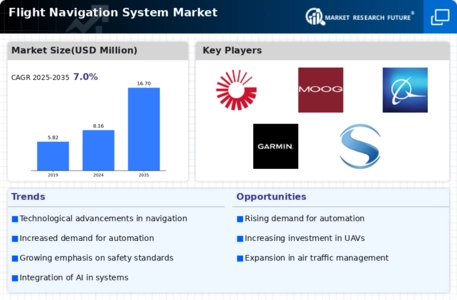Emerging Markets
Emerging markets are becoming increasingly relevant in the Global Flight Navigation System Market Industry. Countries in Asia-Pacific and Latin America are witnessing rapid growth in their aviation sectors, leading to a heightened demand for advanced navigation systems. The expansion of low-cost carriers and increased investment in airport infrastructure contribute to this trend. As these regions develop their aviation capabilities, the need for reliable and efficient flight navigation systems becomes paramount, presenting significant opportunities for market players to capitalize on.
Regulatory Compliance
Regulatory compliance plays a crucial role in shaping the Global Flight Navigation System Market Industry. Governments and aviation authorities worldwide are implementing stringent regulations to enhance air safety and operational efficiency. For example, the Federal Aviation Administration (FAA) in the United States mandates the adoption of advanced navigation technologies for commercial aviation. This regulatory environment drives the demand for innovative flight navigation systems that meet compliance standards, thereby fostering market growth and encouraging manufacturers to invest in research and development.
Increasing Air Traffic
The Global Flight Navigation System Market Industry is significantly influenced by the rising volume of air traffic worldwide. As more individuals and goods are transported via air, the demand for efficient navigation systems escalates. According to projections, the market is expected to grow at a CAGR of 6.72% from 2025 to 2035, potentially reaching 16.7 USD Billion by 2035. This growth necessitates the development of advanced navigation systems that can handle increased traffic while ensuring safety and compliance with international regulations.
Technological Advancements
The Global Flight Navigation System Market Industry is experiencing rapid technological advancements, particularly in satellite navigation and communication systems. Innovations such as the integration of artificial intelligence and machine learning into navigation systems enhance accuracy and efficiency. For instance, the implementation of advanced GPS technology allows for real-time data processing, which is crucial for flight safety and operational efficiency. As a result, the market is projected to reach 8.16 USD Billion in 2024, reflecting the growing demand for sophisticated navigation solutions that improve flight operations and reduce delays.
Market Trends and Projections
Focus on Safety and Efficiency
The emphasis on safety and operational efficiency is a driving force in the Global Flight Navigation System Market Industry. Airlines and aviation operators are prioritizing technologies that enhance safety protocols and streamline operations. For instance, systems that provide real-time weather updates and traffic alerts can significantly reduce the risk of accidents. This focus on safety not only meets regulatory requirements but also boosts consumer confidence in air travel. Consequently, the market is likely to see increased investment in navigation systems that prioritize these aspects, further propelling growth.









Leave a Comment